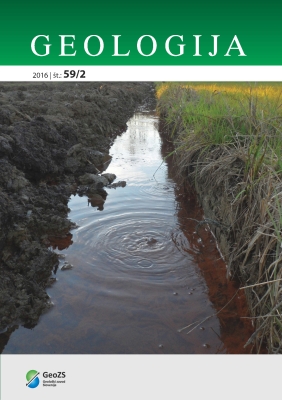Hydrogeochemical and isotopic characterization of Pesnica River, Slovenia
DOI:
https://doi.org/10.5474/geologija.2016.010Abstract
The surface water geochemistry and carbon cycling studied here depend mainly on geological composition of the river catchment. The investigated surface waters in the river Pesnica catchment that are heavily hydromorphologicaly altered (reservoirs, channelization, land melioration Systems) represent waters influenced by chemical weathering of carbonates and of mostly clastic rocks (claystone, sandstones, marlstones and siltstones). The objectives of our study were to analyze hydrogeochemical and isotopic composition of dissolved (δ13CDIC) and particulate carbon (δ13CPOC) with characterization of suspended matter and evaluate biogeochemical processes in Pesnica River in Slovenia before and after the retention. Surface waters are generally close to Saturation regarding calcite and dolomite, dissolved CO2 is 49 to 1000 times oversaturated relative to atmosphere. δ13CDIC was in the range from -14.8 to -4.2 ‰ and shows following biogeochemical processes in river System: degradation of organic matter, dissolution of carbonates and biological activity, which was confirmed with SEM microscopy and EDXS microanalysis. Results of SEM/EDXS showed that suspended matter is composed of K, Mg and Ca from locations Pesnica 1 and Pesnica 2 (above retention Perniško lake). Sample from Pesnica 3 (below retention) shows higher biological activity, while sample from Pesnica 4 (tributary of Pesnica, drainage Channel Biš) contains a lot of particles of microporous structure and fiber structure, which are probably of anthropogenic origin. δ13CPOC is changing from -29.5 to-27.6 ‰ and showed different stages of degraded terrestrial material. More negative δ13CPOC are shown at location at drainage Channel Biš and show higher terrestrial input in river system as locations 1, 2 and 3 Pesnica, which have higher δ13CPOC values. This first results about suspended matter in Pesnica watershed serve for evaluation of anthropogenic influences specially in relation with further influences and longer time planning of sustainable river water management.Downloads
How to Cite
Kanduč, T., Blažeka, Željko, Žigon, S., Robinson, J. A., Kračun, M., Levačič, I., Jerebic, A., Mori, N., Samardžija, Z., & Kocman, D. (2016). Hydrogeochemical and isotopic characterization of Pesnica River, Slovenia. Geologija, 59(2), 179–192. https://doi.org/10.5474/geologija.2016.010
Issue
Section
Articles

